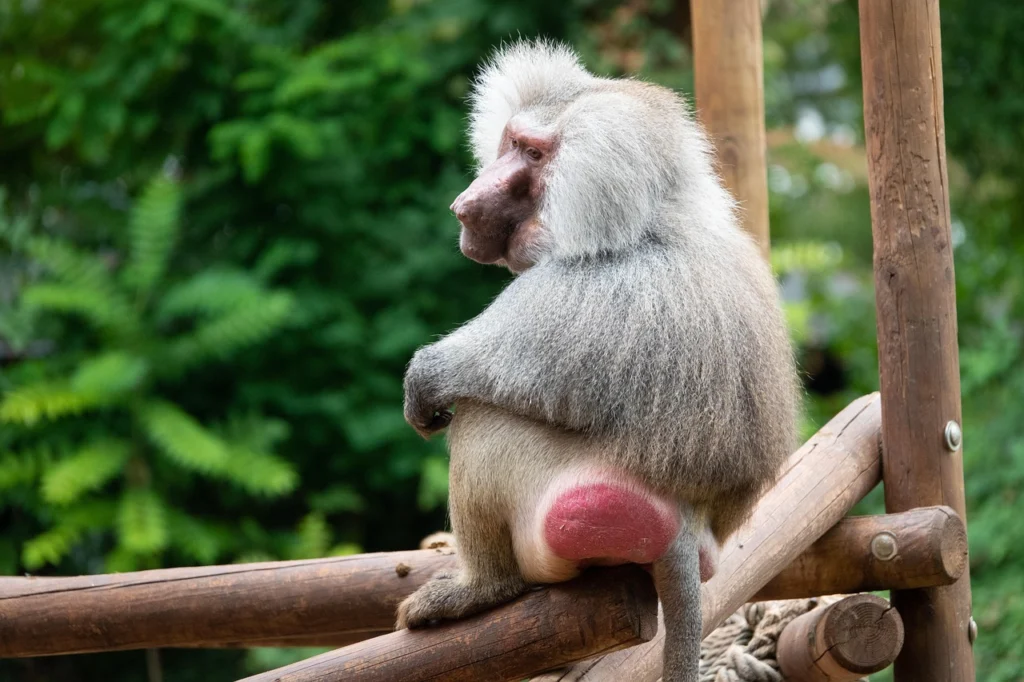Table of Contents
Scientific Classification
| Kingdom | Animalia |
| Phylum | Chordata |
| Class | Mammalia |
| Order | Primates |
| Family | Cercopithecidae |
| Genus | Papio |
| Species | P. hamadryas |
| Scientific Name | Papio hamadryas |
Description
The Hamadryas Baboon is truly a fascinating and intelligent primate. It carries an air of both ancient wisdom and sacredness. Once held in high regard by the ancient Egyptians, this baboon is far from just another monkey. With its striking silver mane, it exudes a regal presence. Its face resembles that of a dog, and its robust social structure really sets it apart from other baboon species.
The males are notably larger and more flamboyant, tipping the scales at up to 30 kg (66 lbs) and reaching nearly 80 cm (31 inches) in body length. Their most eye-catching feature is the impressive cape of silvery-grey fur that cascades over their shoulders like a majestic cloak. In contrast, females are smaller and don’t have the prominent mane. They sport a brownish-tan coat and typically weigh around 15 kg (33 lbs).
What really makes Hamadryas baboons stand out are their vibrant rumps, especially in females. The color intensifies during their estrous cycle, which plays a crucial role in their communication and mating rituals.
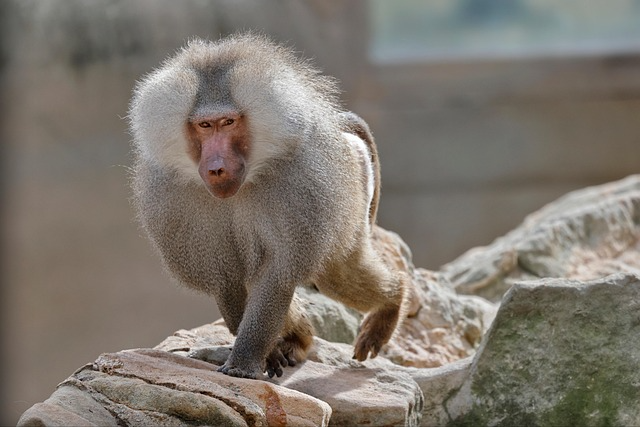
Distribution
The Hamadryas Baboon has a pretty distinctive geographical range compared to other baboon species.
You can find them in:
Northeastern Africa: Ethiopia, Eritrea, Djibouti, Somalia, and Sudan
Southwestern Arabia: Especially in Yemen and some areas of Saudi Arabia
These baboons tend to prefer dry habitats, often making their homes on cliffs and steep slopes. These locations not only offer them shelter but also great vantage points to keep an eye on their surroundings.
Habitat
These baboons have a knack for thriving in some pretty tough environments. You’ll find them in rocky, dry areas, savannahs, and even on steep cliffs—places that might seem unwelcoming to most other primates.
Here are some key features of their habitat:
– Cliff faces and rocky outcrops provide a safe haven for them at night.
– They forage during the day in areas with sparse vegetation.
– Access to water is vital, as it often dictates how far they can roam in search of food.
Their sleeping habits are quite intriguing. They scale steep cliffs to rest in large groups on narrow ledges, which helps keep them out of reach from land predators.

Diet
The Hamadryas Baboon is an omnivore, though it leans heavily towards plant-based food. In its tough home, it has a flexible and opportunistic diet.
Common dietary items include:
- Grasses and roots
- Fruits and leaves
- Insects and small vertebrates
- Tree gums and tubers
They often forage in groups. Males guard the harem while females dig for roots or catch insects. They move strategically across the landscape.
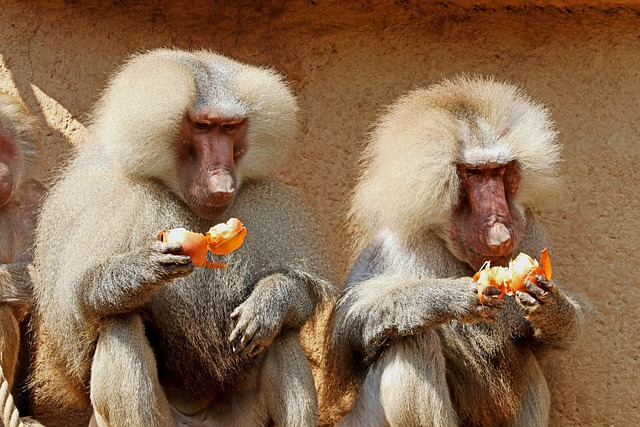
Behavior
Social behavior is perhaps the most defining trait of the Hamadryas Baboon. Their multi-level society is among the most complex of any non-human primate.
Social Structure:
- One-male unit (OMU): This is the main group. It has one dominant male, along with 1–10 females and their young.
- Clan: Several OMUs that are usually related males.
- Band: A larger grouping of clans (up to 400 individuals).
- Troop: A temporary congregation of several bands, often observed at sleeping cliffs.
Males are very protective of their females. They often herd them to keep control. Sometimes, they use visual threats or physical force. This might seem harsh, but it helps their survival and keeps the group together.
Communication includes:
- Facial gestures like lip-smacking, eyebrow flashes
- Vocalizations ranging from grunts to barks
- Mounting gestures that are not always sexual but serve social functions
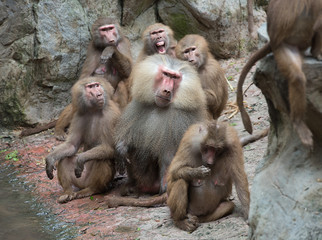
Lifespan
In the wild, Hamadryas Baboons typically have a lifespan of about 20 to 25 years. However, this can vary depending on their environment and the dangers posed by predators.
In captivity, with the right medical care and a balanced diet, these baboons can live anywhere from 30 to 35 years. Interestingly, like many primate species, female baboons tend to outlive their male counterparts. This is largely because they often lead less perilous lives and are less likely to get injured in fights for dominance.
Reproduction and Lifecycle
Mating in Hamadryas baboons is closely tied to social structure. The main male in a harem is the top breeder. He usually limits access to females when they are fertile.
Key Aspects of Lifecycle:
- Gestation period: Approximately 170–180 days
- Offspring: Usually a single infant
- Birth interval: About 2 years
Infants are born with dark black fur, which gradually turns lighter with age. Mothers usually care for infants, but fathers can also be very involved. They often carry and groom their young, especially if they think they are the father.
Young males leave their birth group. They try to take over harems by challenging other males. In contrast, females usually stay with their original group.

Predators
Though intelligent and organized, Hamadryas baboons are not without threats in the wild.
Natural predators include:
- Leopards
- Hyenas
- Large birds of prey (targeting infants)
- Humans (through hunting and habitat disruption)
Their defense mechanism is social. When threatened, males group up. They bare their teeth and bark to scare off predators, while females and young ones retreat.
Sleeping on high cliffs at night offers safety. Terrestrial predators find it hard to reach these spots.
Adaptations
The Hamadryas Baboon has special skills to survive in dry, rocky areas.
Physical and Behavioral Adaptations:
- Tough ischial callosities: Allow sitting on rocky surfaces for long periods.
- Cliff-sleeping behavior: Reduces predation risk.
- Coat coloration: The male’s silvery fur helps reflect heat in the sun, a crucial trait in desert heat.
- Multi-tiered society: Helps in resource sharing, group defense, and efficient foraging.
Their thick skin on hands and feet shows how evolution helped them climb and walk on rough ground.
Mating Season
Hamadryas baboons breed all year. However, climate can affect their activity. They tend to breed more during the rainy season when food is plentiful.
Females show clear signs of fertility with sexual swellings. This helps males notice when they are in estrus. During this time, the male stays close. He watches her closely and protects her, hardly letting her out of sight.
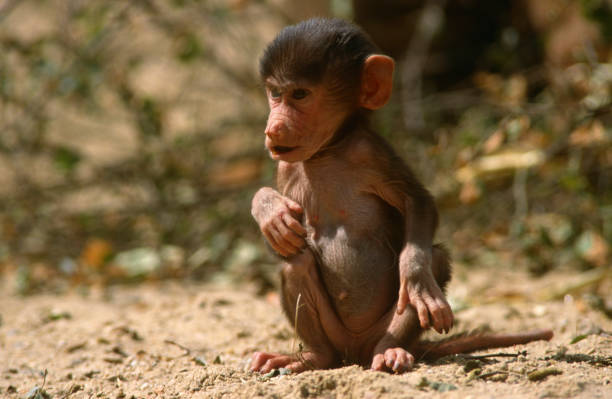
Breeding
Breeding involves a series of behavioral displays and rituals. Males may:
- Groom females excessively
- Herd them away from rival males
- Show increased aggression to other troop members
After mating, if the female becomes pregnant, she is less sexually active. This change allows the male to save energy and pay more attention to other harem members.
Infants are born after about six months, and mother-baby bonds are deeply affectionate. Nursing lasts for several months. Then, weaning happens slowly, and the young join juvenile groups.
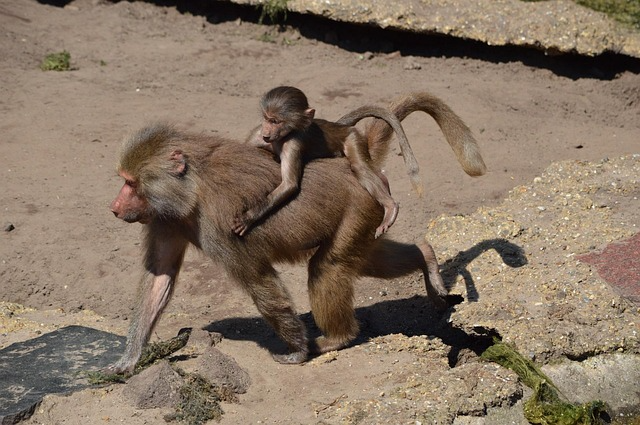
Interesting Facts
- In Ancient Egypt, Hamadryas baboons were special. They were often mummified and linked to Thoth, the god of wisdom.
- Facial communication is so nuanced that researchers compare it to human non-verbal behavior.
- Great for photos: Their lively faces and striking manes attract wildlife photographers.
- Males can take in orphaned young. They may also team up with older females to boost their harem control.
- Their society serves as a great example for studying how humans evolve socially. This is especially true in patriarchal systems.
Conservation Status
The IUCN Red List classifies the Hamadryas Baboon as Least Concern. However, this doesn’t mean they are free from threats.
Threats include:
- Habitat destruction due to agriculture and urbanization
- Human-wildlife conflict, especially in areas where they raid crops
- Capture for pet trade or research
We need conservation efforts to watch populations, especially in Arabia. There, habitat fragmentation is on the rise. Education programs that focus on coexistence and ecology are vital for their future.
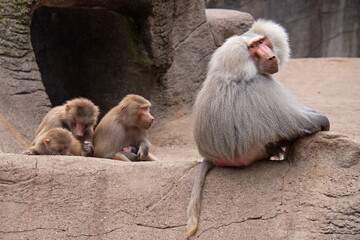
Final Thoughts
The Hamadryas Baboon isn’t just an ancient symbol; it’s a true marvel of the natural world. This remarkable creature embodies intelligence, social intricacy, and remarkable adaptability. From the rugged cliffs of Ethiopia to the lush valleys of Yemen, these baboons stand tall and proud. With a rich history and a vital role in their ecosystem, they are truly fascinating.
To safeguard the Hamadryas Baboon, we must acknowledge our bond with primates. It’s our responsibility to ensure that their legacy endures for future generations.
